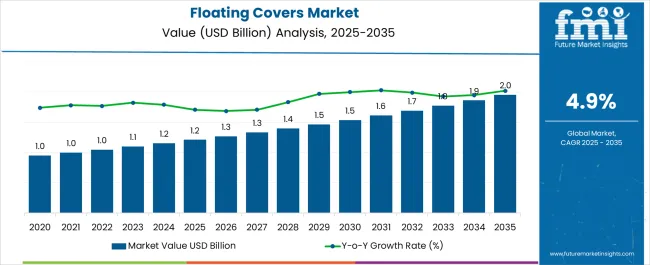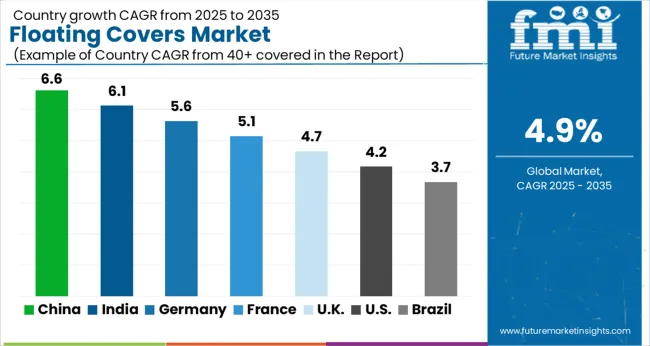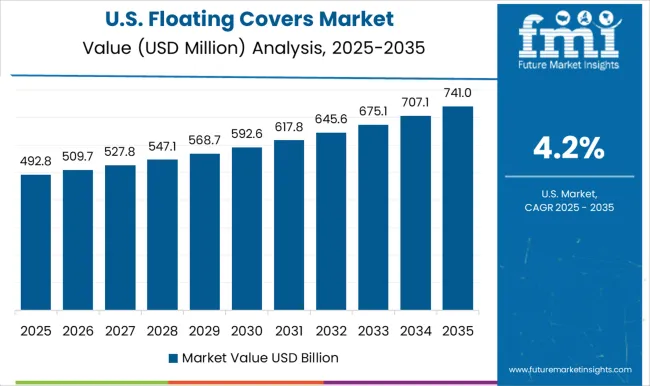The Floating Covers Market is estimated to be valued at USD 1.2 billion in 2025 and is projected to reach USD 2.0 billion by 2035, registering a compound annual growth rate (CAGR) of 4.9% over the forecast period.

| Metric | Value |
|---|---|
| Floating Covers Market Estimated Value in (2025 E) | USD 1.2 billion |
| Floating Covers Market Forecast Value in (2035 F) | USD 2.0 billion |
| Forecast CAGR (2025 to 2035) | 4.9% |
The floating covers market is experiencing consistent growth driven by increasing emphasis on water conservation, environmental protection, and the prevention of evaporation losses in storage facilities. Rising concerns over contamination control and the need for cost effective water management solutions have encouraged adoption across sectors such as mining, wastewater treatment, and agriculture.
Advances in polymer engineering and fabrication techniques are enabling the development of durable, UV resistant, and chemical tolerant floating covers suitable for long term applications. Regulatory pressures focusing on water quality standards and emissions control are further supporting demand.
The market outlook remains positive as industries increasingly view floating covers as an efficient and sustainable method to enhance resource management, extend storage life, and align with environmental compliance goals.
The linear low density polyethylene segment is projected to account for 48.60% of the overall market revenue by 2025, making it the leading material type. This dominance is attributed to its superior flexibility, durability, and resistance to environmental stress cracking.
The material offers excellent tensile strength and UV stability, which are critical in outdoor applications where floating covers are exposed to harsh weather conditions. Its relatively low production cost combined with strong adaptability for large scale cover manufacturing has further supported its adoption.
As industries prioritize longevity and performance efficiency in containment systems, linear low density polyethylene continues to be the preferred material for floating cover applications.
The mining storage ponds segment is expected to hold 42.70% of the total revenue by 2025 within the application category, establishing it as the largest segment. This growth is driven by the necessity to manage tailings, process water, and leachate effectively while ensuring environmental compliance.
Floating covers provide an effective barrier that minimizes evaporation, prevents contamination, and supports safe water recycling in mining operations. Increasing global mining activity and stricter environmental regulations on water discharge and evaporation losses have further accelerated demand.
As sustainability becomes a core operational priority in the mining sector, floating covers are being recognized as an essential solution for efficient water management and regulatory alignment, reinforcing the dominance of this application segment.
| Particulars | Details |
|---|---|
| H1 2024 | 4.7% |
| H1 2025 Projected | 4.8% |
| H1 2025 Expected | 4.5% |
| BPS Change - H1, 2025 (O) - H1, 2025 (P) | (-) 30 ↓ |
| BPS Change - H1, 2025 (O) - H1, 2024 | (-) 20 ↓ |
Future Market Insights prepared a comparison and review analysis of the dynamics of the floating covers market, which is principally subjected to an array of industry factors along with a few definite influences such as increasing usage of plastic material along with rising effects on marine and terrestrial environments that are hindering the growth of floating covers market.
The floating covers industry is expected to register a 4.9% CAGR between 2025 and 2035, up from the 4.6% CAGR recorded during 2020 to 2025.
The large-scale application of floating covers in a wide range of industries is anticipated to impact the market positively shortly. When water is stored in a tank under the floating covers, it gradually develops high stability. Thus, their usage is likely to increase in the upcoming years.The large-scale application of floating covers in a wide range of industries is anticipated to impact the market positively in the near future. When water is stored in a tank under the floating covers, it gradually develops high stability. Thus, their usage is likely to increase in the upcoming years.
As per the latest market report published by Future Market Insights (FMI), the floating covers industry is anticipated to reach USD 2 billion by the end of 2035. FMI identifies key developments in the market over the short term, medium term, and long term.
| Duration | Market Analysis |
|---|---|
| Short Term Growth (2025 to 2025) | The market is anticipated to reach USD 1.2 billion by 2025. The market is expected to be positively influenced by the cost-effectiveness of the available floating covers. Additionally, floating covers allow snow or rain to melt or pass through specific areas, without contaminating the water. These properties are expected to bolster the uptake of floating covers in various application segments from 2025 to 2025. |
| Medium Term Growth (2025 to 2035) | By 2035, the market is estimated to generate revenue of USD 1.40 billion. The growing awareness regarding the protection and safe storage of water bodies such as lakes and ponds is anticipated to create growth opportunities for the market in the forthcoming years. |
| Long Term Growth (2035 to 2035) | By the end of 2035, the market is slated to reach USD 1.69 billion. Over the long-term, the market is projected to be driven by the increasing application of floating geosynthetic covers by agricultural owners and government water authorities. In addition to this, the growing freshwater shortage and climate change are projected to drive industries and governments to adopt technologies that help conserve the dwindling freshwater resources. As a result, the floating covers industry is projected to have a significant growth trajectory over the forecast period. |
An increasing number of resource processing and mining projects in places where the rate of evaporation and water scarcity is high is expected to drive the demand for floating covers. The water resources in these areas need to be protected and therefore, floating geomembrane covers are anticipated to gain immense popularity.
The urgent need to control pond water temperatures is likely to propel growth in the market. Various manufacturers are introducing novel products to meet the high unmet needs of customers across the globe.
Layfield, for instance, offers REVOC Insulated floating cover that adds a layer of insulation permanently on the top of open ponds. This additional layer is capable of controlling water temperatures and conserving the energy for heated water ponds. The development of such state-of-the-art products by leading players is expected to drive the market in the forthcoming years.

| The United States Market Size (2035) | USD 261.1 million |
|---|---|
| Estimated CAGR | 3.4% |
| China Market Size (2035) | USD 2 million |
|---|---|
| Estimated CAGR | 6.3% |
| India Market Size (2035) | USD 190.5 million |
|---|---|
| Estimated CAGR | 7.2% |
| Germany Market Size (2035) | USD 81.6 million |
|---|---|
| Estimated CAGR | 2.3% |
| France Market Size (2035) | USD 58.7 million |
|---|---|
| Estimated CAGR | 2.3% |
| Attributes | Details |
|---|---|
| Market Size (2035) | USD 2 million |
| Market Absolute Dollar Growth (USD million/billion) | USD 162 million |
China floating covers industry is projected to reach USD 2 million by 2035, registering a CAGR of 6.3% from 2025 to 2035. Increasing farming activities in China are projected to boost the floating covers industry. In addition to this, the surging usage of floating covers in Waste water treatment units and water-storing plants is expected to drive growth.
The market is also expected to gain from the implementation of various stringent regulations by the government to protect water bodies from pollution. For instance, in December 2024, the National People's Congress of the People's Republic of China put forward a new rule for protecting wetlands.
This rule prohibits the permanent blockage of water sources to natural wetlands, as well as land reclamation and drainage on wetlands. Similar initiatives by the government are anticipated to support the market in China.
| Historical CAGR (2020 to 2025) | 5.9% |
|---|---|
| Forecast CAGR (2025 to 2035) | 6.3% |

| Attributes | Details |
|---|---|
| Market Size (2035) | USD 261.1 million |
| Market Absolute Dollar Growth (USD million/billion) | USD 73.7 million |
The United States floating covers industry is projected to attain USD 261.1 million by 2035, expanding at a CAGR of 3.4% over the forecast period. The high demand for treated water from the pharmaceutical and beverages industries is expected to bolster the floating covers industry in the United States. Also, the demand for demineralized water owing to the urgent need for high power generation for supporting industrial growth is likely to augment the market.
The rising demand for freshwater protection in the country is anticipated to push the market. According to the University of Michigan’s Center for Sustainable Systems, around 1 billion gallons of water were used per day in 2020 in the United States., out of which, 87% was freshwater. This number is likely to rise shortly, thereby providing new growth opportunities in the country.
| Historical CAGR (2020 to 2025) | 3.9% |
|---|---|
| Forecast CAGR (2025 to 2035) | 3.4% |
The presence of various renowned floating cover manufacturers is likely to boost growth in the United Kingdom during the assessment period. These manufacturers consistently aim to develop state-of-the-art products to cater to the high demand from customers. to develop state-of-the-art products to cater to the high demand from customers.
In October 2024, for instance, Genap, a leading provider of waterproof solutions, joined hands with an international dealer to supply and install slurry lagoon covers for Hilderstone Farm in Trent, United Kingdom. These covers are made of Genatex 850 reinforced PVC and are capable of reducing emissions in the environment. All such industry developments in the country are likely to propel the demand for unique floating covers over the forecast period. industry developments in the country are likely to propel the demand for unique floating covers over the forecast period.
In terms of application, the Waste water/liquid treatment segment is expected to register a CAGR of 5.7% over the forecast period, finds FMI. This growth is attributable to the increasing usage of floating covers in Waste water treatment plants to insulate the buildup of organisms, dissuade wildlife from accessing the water, and prevent odors.
The increasing government initiatives in various countries to curb the illegal discharge of Waste water and pollution of naturally occurring water bodies are anticipated to drive the growth of this segment. According to the United Nations, more than 80% of Waste water is released into the environment worldwide without adequate treatment. This is likely to propel the need for Waste water treatment and bolster the growth.of waste water is released into the environment worldwide without adequate treatment. This is likely to propel the need for waste water treatment and bolster growth.
| Historical CAGR (2020 to 2025) | 5.5% |
|---|---|
| Forecast CAGR (2025 to 2035) | 5.7% |
In the agriculture segment, the extensive utilization of floating covers for vegetable protection is expected to have a positive influence on segment growth. Floating covers help protect young crops as they are placed over plants to save them from pests like caterpillars, fleabeetles, onion maggot, etc. The use of floating covers prevents insects from getting near the plants. Additionally, with the help of floating covers, vegetables can enjoy the prolonged growing season as floating covers help retain warmth, and act as a windbreaker.
A floating cover for a pond typically consists of a flexible geomembrane, which is fixed on top of liners that provides windproofing and shade to the pond. Key players in the market are developing distinct and advanced floating covers for mining storage ponds to differentiate and offer a myriad of advantages as opposed to typical geomembrane covers. The modern and recently developed floating covers are made of thousands of single, identical, and symmetrical elements that are automated to form a barrier on top of liquid bodies, irrespective of their size. The increasing utilization of floating covers for reservoirs is projected to elevate the segment growth.
The linear low-density polyethylene (LLDPE) covers are best suited for applications requiring high material flexibility, durability, and strength. In addition to this, LLDPE covers are capable of elongating under stress, which enables them to maintain their integrity without getting damaged under localized differential settlement situations. These are also resistant to ultraviolet exposure and low temperatures. Such types of covers are extensively used in various applications such as retention ponds, lagoons, raw water treatment reservoirs, and canals. As a result, boosting the segment growth.
The floating covers industry exhibits the presence of a large number of manufacturers. In an attempt to gain a competitive edge, competitors are engaging in mergers and acquisitions, collaborations, and joint ventures. In addition to this, a few key players focus on bagging new orders from well-known firms to deliver their in-house products for use in numerous projects. in numerous projects.
For instance
| Attribute | Details |
|---|---|
| Forecast Period | 2020 to 2025 |
| Historical Data Available for | 2025 to 2035 |
| Market Analysis | Units for Volume and USD million/billion for Value |
| Key Regions Covered | North America; Latin America; Western Europe; Eastern Europe; Asia Pacific; Middle East and Africa |
| Key Countries Covered | The United States, Brazil, Mexico, Canada, the United Kingdom, Germany, France, Spain, Italy, Russia, Argentina, Brunei, Cambodia, Indonesia, Laos, Malaysia, Myanmar, the Philippines, Singapore, Thailand, Vietnam, Australia, Poland, China, New Zealand, Japan, GCC countries, South Africa, others. |
| Key Market Segments Covered | Material, Application, and Region |
| Key Companies Profiled | Raven Industries Inc.; GSE Environmental, Inc.; Royal TenCate; Cooley Group; Nilex Inc.; FLI France SAS; Hexa-Cover A/S; Industrial & Environmental Concepts, Inc.; Advanced Water Treatment Technologies; Aquatan (Pty) Ltd. |
| Pricing | Available upon Request |
The global floating covers market is estimated to be valued at USD 1.2 billion in 2025.
The market size for the floating covers market is projected to reach USD 2.0 billion by 2035.
The floating covers market is expected to grow at a 4.9% CAGR between 2025 and 2035.
The key product types in floating covers market are linear low-density polyethylene, high-density polyethylene, polyvinyl chloride, polypropylene and other materials.
In terms of application, mining storage ponds segment to command 42.7% share in the floating covers market in 2025.






Full Research Suite comprises of:
Market outlook & trends analysis
Interviews & case studies
Strategic recommendations
Vendor profiles & capabilities analysis
5-year forecasts
8 regions and 60+ country-level data splits
Market segment data splits
12 months of continuous data updates
DELIVERED AS:
PDF EXCEL ONLINE
Floating Microelectrode Array (FMA) Market Size and Share Forecast Outlook 2025 to 2035
Floating Docks Market Size and Share Forecast Outlook 2025 to 2035
Floating Fountains Market Size and Share Forecast Outlook 2025 to 2035
Floating Valve Trays Market Size and Share Forecast Outlook 2025 to 2035
Floating Solar PV Market Size and Share Forecast Outlook 2025 to 2035
Floating Offshore Wind Energy Market Size and Share Forecast Outlook 2025 to 2035
Floating Power Plant Market Growth – Trends & Forecast 2025 to 2035
Market Share Distribution Among Floating Hotel Providers
Floating Hotel Industry Analysis by Type, by End User, by Tourist Type, by Booking Channel, and by Region – Forecast for 2025-2035
Floating LNG Power Vessel Market Growth – Trends & Forecast 2024-2034
Solar Floating Pool Lights Market Insights – Trends, Demand & Growth 2025-2035
Dust Covers Market
Spray Covers Market Size and Share Forecast Outlook 2025 to 2035
Spa Hot Tub Covers Market Size and Share Forecast Outlook 2025 to 2035
Marine Hatch Covers Market Growth - Trends & Forecast 2025 to 2035
Temporary Road Covers Market Size and Share Forecast Outlook 2025 to 2035
Nonwoven Floor Covers Market Size and Share Forecast Outlook 2025 to 2035
Insulated Drum Covers Market Size and Share Forecast Outlook 2025 to 2035
Thermal Pallet Covers Market Size and Share Forecast Outlook 2025 to 2035
Waterproof Shoe Covers Market Analysis - Trends, Growth & Forecast 2025 to 2035

Thank you!
You will receive an email from our Business Development Manager. Please be sure to check your SPAM/JUNK folder too.
Chat With
MaRIA